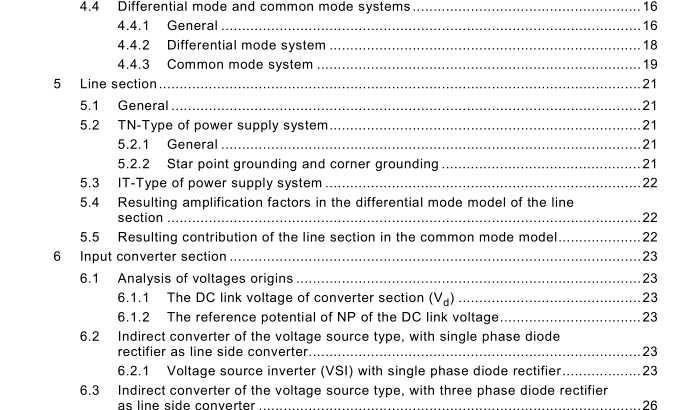IEC TS 61800-8:2010 pdf download – Adjustable speed electrical power drive systems – Part 8: Specification of voltage on the power interface
5 Line section
5.1 General Influence of the power supply systems is given in this section. The main different possible power supply systems (TN, TT, and IT systems) are described in Annex A, including grounding and influence. For that Line section and the Input converter section of Clause 6, the TT power supply system is not separately considered, as it provides no different influence compared to the TN system.
5.2 TN-Type of power supply system 5.2.1 General TN power supply systems have one point directly earthed, the exposed-conductive-parts of the installation being connected to that point by protective conductors. Three types of TN systems are considered according to the arrangement of neutral and protective conductors, as follows: – TN-S system: in which throughout the system, a separate protective conductor is used;
– TN-C-S system: in which neutral and protective functions are combined in a single conductor in a part of the system;
– TN-C system: in which neutral and protective functions are combined in a single conductor throughout the system.
5.2.2 Star point grounding and corner grounding In general one arbitrary point might be earthed in the mentioned supply systems. Resulting from this earthing point different common mode voltages occur. According to Figures 1 1 and 1 4 the common mode voltage will reach values between minimum and maximum:
• where minimum is defined in case of star point grounding with k C0 = 0
• where maximum is defined in case of corner grounding as k C0 = V S / SQR 3
5.3 IT-Type of power supply system In case of IT-power supply system all conductors are insulated from the ground potential. This leads (see Figure 1 1 ) to an undefined value of V C0 . In practical cases the parasitic impedances are more or less symmetrical which leads to a value of k C0 = 0. Deviations from this case may occur if one earth fault happens in such an installation. In such cases the value might reach k C0 = 1 / SQR 3.
6 Input converter section 6.1 Analysis of voltages origins The low frequency grounding potential of the inverter output terminals is determined by the DC link voltage (V d ) and the reference potential of the DC link voltage (V G1 ) (see Figure 5.) Grounding potential of the converter output terminals = V G1 ± V d /2 (1 8) When the upper side switch of inverter is switched on, the grounding potential V G1 + V d /2 appears at the output of the converter. And if the lower side switch of inverter is switched on, the grounding potential V G1 – V d /2 appears at the output of the inverter.
6.1.1 The DC link voltage of converter section (V d ) The DC link voltage is mainly determined by the type of rectifier and by the filtering effect of the impedance at supply line and/or DC line and the large DC capacitor. The DC voltage ripple is usually negligible. The DC link voltage is affected by the following items;
– Type of rectifier (single phase diode, three phase diode, active converter);
– Type of inverter (single phase/three phase and with/without DC brake);
– Line side commutation impedance;
– Load
6.1.2 The reference potential of NP of the DC link voltage The reference potential V G1 of the DC link voltage is usually very close to the grounding potential, if a TN or IT line side (see Clause 5) grounding system is applied or the neutral point of the DC capacitor is grounded by some means. Even if a non-grounded (IT) supply system is applied, the average value of V G1 may remain close to grounding potential. But it is also influenced by the grounding impedance of output filter, cable and motor.IEC TS 61800-8 pdf download.
